Submitted:
27 March 2023
Posted:
27 March 2023
You are already at the latest version
Abstract
Keywords:
1. Introduction
- The results of sentiment analysis using the VADER (for Valence Aware Dictionary for sEntiment Reasoning) approach shows that nearly half the Tweets (actual percentage being 46.88%) had a negative sentiment. It was followed by Tweets that had a positive sentiment (31.97%) and Tweets that had a neutral sentiment (21.14%).
- Using concepts of text analysis, the top 50 hashtags associated with these Tweets were obtained. These hashtags are presented in the paper.
- Using concepts of text analysis, the top 100 most frequently used words featured in these Tweets were obtained. The findings show that some of the commonly used words involved Twitter users directly referring to either or both viruses. In addition to this, the presence of words such as "Polio", "Biden", "Ukraine", "HIV", "climate", and "Ebola" in the list of the top 100 most frequent words indicate that topics of conversations on Twitter in the context of COVID-19 and MPox also included a high level of interest related to other viruses, President Biden, and Ukraine.
2. Literature Review
2.1. Recent Works that Focused on Sentiment analysis of Tweets about COVID-19
2.2. Recent Works that Focused on Sentiment Analysis of Tweets about MPox
3. Materials and Method
- The desktop version of Hydrator was downloaded and installed on a Computer with Microsoft Windows 10 Pro operating system (Version 10.0.19043 Build 19043) comprising of Intel(R) Core(TM) i7-7600U CPU @ 2.80GHz, 2904 Mhz, 2 Core(s), and 4 Logical Processor(s)
- The Hydrator app was then connected to the Twitter API by clicking on the "Link Twitter Account" button on the app's interface.
- This next step involved uploading a dataset file to the Hydrator app for hydration. As the Hydrator App allows only one file to be uploaded at a time, so all the dataset files were merged to create one .txt file, which was uploaded to the app.
- Then specific information about the uploaded dataset file (such as Title, Creator, Publisher, and URL) was entered in the Hydrator app, and then the "Add Dataset" button was clicked to complete the process of dataset upload
- Thereafter, in the "Datasets" tab of the Hydrator App, the "Start" button was clicked to initiate the process of hydration.
- a)
- VADER distinguishes itself from LIWC as it is more sensitive to sentiment expressions in social media contexts.
- b)
- The General Inquirer suffers from a lack of coverage of sentiment-relevant lexical features common to social text.
- c)
- The ANEW lexicon is also insensitive to common sentiment-relevant lexical features in social text.
- d)
- The SentiWordNet lexicon is very noisy; a large majority of synsets have no positive or negative polarity.
- e)
- The Naïve Bayes classifier involves the naive assumption that feature probabilities are independent of one another.
- f)
- The Maximum Entropy approach makes no conditional independence assumption between features and thereby accounts for information entropy (feature weightings).
- g)
- In general, machine learning classifiers require (often extensive) training data, which are, as with validated sentiment lexicons, sometimes troublesome to acquire.
- h)
- In general, machine learning classifiers also depend on the training set to represent as many features as possible.
4. Results and Discussions
4.1. Results of Sentiment Analysis
4.2. Results of Text Analysis
4.3. Comparative Study with Prior Works in this Field
5. Conclusions
Funding
Institutional Review Board Statement
Informed Consent Statement
Data Availability Statement
Conflicts of Interest
References
- Katz, M.; Nandi, N. Social Media and Medical Education in the Context of the COVID-19 Pandemic: Scoping Review. JMIR Med. Educ. 2021, 7, e25892. [Google Scholar] [CrossRef]
- Lee, H.E.; Cho, J. Social Media Use and Well-Being in People with Physical Disabilities: Influence of SNS and Online Community Uses on Social Support, Depression, and Psychological Disposition. Health Commun. 2019, 34, 1043–1052. [Google Scholar] [CrossRef] [PubMed]
- Kavada, A. Social Media as Conversation: A Manifesto. Soc. Media Soc. 2015, 1, 205630511558079. [Google Scholar] [CrossRef]
- Twitter: Number of Users Worldwide 2024. Available online: https://www.statista.com/statistics/303681/twitter-users-worldwide/ (accessed on March 26 2023).
- Hutchinson, A. New Study Shows Twitter Is the Most Used Social Media Platform among Journalists. Available online: https://www.socialmediatoday.com/news/new-study-shows-twitter-is-the-most-used-social-media-platform-among-journa/626245/ (accessed on March 26 2023).
- Biggest Social Media Platforms 2023. Available online: https://www.statista.com/statistics/272014/global-social-networks-ranked-by-number-of-users/ (accessed on March 26 2023).
- Lazard, A.J.; Scheinfeld, E.; Bernhardt, J.M.; Wilcox, G.B.; Suran, M. Detecting Themes of Public Concern: A Text Mining Analysis of the Centers for Disease Control and Prevention's Ebola Live Twitter Chat. Am. J. Infect. Control 2015, 43, 1109–1111. [Google Scholar] [CrossRef] [PubMed]
- Bolotova, Y.V.; Lou, J.; Safro, I. Detecting and Monitoring Foodborne Illness Outbreaks: Twitter Communications and the 2015 U.S. Salmonella Outbreak Linked to Imported Cucumbers. arXiv [stat.AP] 2017.
- Gomide, J.; Veloso, A.; Meira, W.; Almeida, V.; Benevenuto, F.; Ferraz, F.; Teixeira, M. Dengue Surveillance Based on a Computational Model of Spatio-Temporal Locality of Twitter. In Proceedings of the 3rd International Web Science Conference; ACM: New York, NY, USA, 2011. [Google Scholar]
- Tomaszewski, T.; Morales, A.; Lourentzou, I.; Caskey, R.; Liu, B.; Schwartz, A.; Chin, J. Identifying False Human Papillomavirus (HPV) Vaccine Information and Corresponding Risk Perceptions from Twitter: Advanced Predictive Models. J. Med. Internet Res. 2021, 23, e30451. [Google Scholar] [CrossRef]
- Lee, S.Y.; Khang, Y.H.; Lim, H.K. Impact of the 2015 Middle East Respiratory Syndrome Outbreak on Emergency Care Utilization and Mortality in South Korea. Yonsei Med. J. 2019, 60, 796–803. [Google Scholar] [CrossRef]
- Radzikowski, J.; Stefanidis, A.; Jacobsen, K.H.; Croitoru, A.; Crooks, A.; Delamater, P.L. The Measles Vaccination Narrative in Twitter: A Quantitative Analysis. JMIR Public Health Surveill. 2016, 2, e1. [Google Scholar] [CrossRef] [PubMed]
- Fu, K.-W.; Liang, H.; Saroha, N.; Tse, Z.T.H.; Ip, P.; Fung, I.C.-H. How People React to Zika Virus Outbreaks on Twitter? A Computational Content Analysis. Am. J. Infect. Control 2016, 44, 1700–1702. [Google Scholar] [CrossRef]
- Signorini, A.; Segre, A.M.; Polgreen, P.M. The Use of Twitter to Track Levels of Disease Activity and Public Concern in the US during the Influenza A H1N1 Pandemic. PLoS One 2011, 6, e19467. [Google Scholar] [CrossRef]
- Gesualdo, F.; Stilo, G.; Agricola, E.; Gonfiantini, M.V.; Pandolfi, E.; Velardi, P.; Tozzi, A.E. Influenza-like Illness Surveillance on Twitter through Automated Learning of Naïve Language. PLoS One 2013, 8, e82489. [Google Scholar] [CrossRef]
- Szomszor, M.; Kostkova, P.; de Quincey, E. #swineflu: Twitter Predicts Swine Flu Outbreak in 2009. In Lecture Notes of the Institute for Computer Sciences, Social Informatics and Telecommunications Engineering; Springer Berlin Heidelberg: Berlin, Heidelberg, 2011; ISBN 9783642236341. [Google Scholar]
- Alessa, A.; Faezipour, M. Flu Outbreak Prediction Using Twitter Posts Classification and Linear Regression with Historical Centers for Disease Control and Prevention Reports: Prediction Framework Study. JMIR Public Health Surveill. 2019, 5, e12383. [Google Scholar] [CrossRef] [PubMed]
- Hirschfeld, D. Twitter Data Accurately Tracked Haiti Cholera Outbreak. Nature 2012. [Google Scholar] [CrossRef]
- van der Vyver, A.G. The Listeriosis Outbreak in South Africa: A Twitter Analysis of Public Reaction. Available online: http://www.icmis.net/icmis18/ICMIS18CD/pdf/S198-final.pdf (accessed on March 26 2023).
- Thackeray, R.; Burton, S.H.; Giraud-Carrier, C.; Rollins, S.; Draper, C.R. Using Twitter for Breast Cancer Prevention: An Analysis of Breast Cancer Awareness Month. BMC Cancer 2013, 13, 508. [Google Scholar] [CrossRef] [PubMed]
- Da, BL; Surana, P.; Schueler, S.A.; Jalaly, N.Y.; Kamal, N.; Taneja, S.; Vittal, A.; Gilman, C.L.; Heller, T.; Koh, C. Twitter as a Noninvasive Bio-Marker for Trends in Liver Disease. Hepatol. Commun. 2019, 3, 1271–1280. [Google Scholar] [CrossRef] [PubMed]
- Szvarca, D.; Tabbara, N.; Masur, J.; Greenfest, A.; Clarke, L.M.; Borum, M.L. P013 Unregulated: Medical Companies Use Social Media to Sell Alternative Treatments for Inflammatory Bowel Disease. Inflamm. Bowel Dis. 2019, 25, S8–S8. [Google Scholar] [CrossRef]
- McLean, R.; Shirazian, S. Women and Kidney Disease: A Twitter Conversation for One and All. Kidney Int. Rep. 2018, 3, 767–768. [Google Scholar] [CrossRef]
- Stens, O.; Weisman, M.H.; Simard, J.; Reuter, K. Insights from Twitter Conversations on Lupus and Reproductive Health: Protocol for a Content Analysis. JMIR Res. Protoc. 2020, 9, e15623. [Google Scholar] [CrossRef]
- Cevik, F.; Kilimci, Z.H. Analysis of Parkinson’s Disease Using Deep Learning and Word Embedding Models. acperpro 2019, 2, 786–797. [Google Scholar] [CrossRef]
- Porat, T.; Garaizar, P.; Ferrero, M.; Jones, H.; Ashworth, M.; Vadillo, M.A. Content and Source Analysis of Popular Tweets Following a Recent Case of Diphtheria in Spain. Eur. J. Public Health 2019, 29, 117–122. [Google Scholar] [CrossRef]
- Sugumaran, R.; Voss, J. Real-Time Spatio-Temporal Analysis of West Nile Virus Using Twitter Data. In Proceedings of the 3rd International Conference on Computing for Geospatial Research and Applications; ACM: New York, NY, USA, 2012. [Google Scholar]
- Ksiazek, T.G.; Erdman, D.; Goldsmith, C.S.; Zaki, S.R.; Peret, T.; Emery, S.; Tong, S.; Urbani, C.; Comer, J.A.; Lim, W.; et al. A Novel Coronavirus Associated with Severe Acute Respiratory Syndrome. N. Engl. J. Med. 2003, 348, 1953–1966. [Google Scholar] [CrossRef]
- Fauci, A.S.; Lane, H.C.; Redfield, R.R. Covid-19 - Navigating the Uncharted. N. Engl. J. Med. 2020, 382, 1268–1269. [Google Scholar] [CrossRef]
- CDC SARS-CoV-2 Variant Classifications and Definitions. Available online: https://www.cdc.gov/coronavirus/2019-ncov/variants/variant-classifications.html (accessed on March 26 2023).
- COVID - Coronavirus Statistics - Worldometer. Available online: https://www.worldometers.info/coronavirus/ (accessed on March 26 2023).
- Huang, C.; Wang, Y.; Li, X.; Ren, L.; Zhao, J.; Hu, Y.; Zhang, L.; Fan, G.; Xu, J.; Gu, X.; et al. Clinical Features of Patients Infected with 2019 Novel Coronavirus in Wuhan, China. Lancet 2020, 395, 497–506. [Google Scholar] [CrossRef]
- Iser, B.P.M.; Sliva, I.; Raymundo, V.T.; Poleto, M.B.; Schuelter-Trevisol, F.; Bobinski, F. Suspected COVID-19 Case Definition: A Narrative Review of the Most Frequent Signs and Symptoms among Confirmed Cases. Epidemiol. Serv. Saude 2020, 29, e2020233. [Google Scholar] [CrossRef]
- Al Khatib, H.A.; Benslimane, F.M.; Elbashir, I.E.; Coyle, P.V.; Al Maslamani, MA; Al-Khal, A.; Al Thani, AA; Yassine, H.M. Within-Host Diversity of SARS-CoV-2 in COVID-19 Patients with Variable Disease Severities. Front. Cell. Infect. Microbiol. 2020, 10, 575613. [Google Scholar] [CrossRef]
- McCollum, A.M.; Damon, I.K. Human Monkeypox. Clin. Infect. Dis. 2014, 58, 260–267. [Google Scholar] [CrossRef]
- Magnus, P. von; Andersen, E.K.; Petersen, K.B.; Birch-Andersen, A. A Pox-like Disease in Cynomolgus Monkeys. Acta Pathol. Microbiol. Scand. 2009, 46, 156–176. [Google Scholar] [CrossRef]
- Charniga, K.; Masters, N.B.; Slayton, R.B.; Gosdin, L.; Minhaj, FS; Philpott, D.; Smith, D.; Gearhart, S.; Alvarado-Ramy, F.; Brown, C.; et al. Estimating the Incubation Period of Monkeypox Virus during the 2022 Multi-National Outbreak. bioRxiv 2022. [Google Scholar]
- Jezek, Z.; Szczeniowski, M.; Paluku, K.M.; Mutombo, M. Human Monkeypox: Clinical Features of 282 Patients. J. Infect. Dis. 1987, 156, 293–298. [Google Scholar] [CrossRef] [PubMed]
- Centers for Disease Control and Prevention (CDC) Update: Multistate Outbreak of Monkeypox--Illinois, Indiana, Kansas, Missouri, Ohio, and Wisconsin, 2003. MMWR Morb. Mortal. Wkly. Rep. 2003, 52, 561–564.
- Vaughan, A.; Aarons, E.; Astbury, J.; Balasegaram, S.; Beadsworth, M.; Beck, C.R.; Chand, M.; O'Connor, C.; Dunning, J.; Ghebrehewet, S.; et al. Two Cases of Monkeypox Imported to the United Kingdom, September 2018. Euro Surveill. 2018, 23. [Google Scholar] [CrossRef] [PubMed]
- Yinka-Ogunleye, A.; Aruna, O.; Dalhat, M.; Ogoina, D.; McCollum, A.; Disu, Y.; Mamadu, I.; Akinpelu, A.; Ahmad, A.; Burga, J.; et al. Outbreak of Human Monkeypox in Nigeria in 2017-18: A Clinical and Epidemiological Report. Lancet Infect. Dis. 2019, 19, 872–879. [Google Scholar] [CrossRef]
- CDC 2022 Mpox Outbreak Global Map. Available online: https://www.cdc.gov/poxvirus/mpox/response/2022/world-map.html (accessed on March 26 2023).
- Medhat, W.; Hassan, A.; Korashy, H. Sentiment Analysis Algorithms and Applications: A Survey. Ain Shams Eng. J. 2014, 5, 1093–1113. [Google Scholar] [CrossRef]
- Vijay, T.; Chawla, A.; Dhanka, B.; Karmakar, P. Sentiment Analysis on COVID-19 Twitter Data. In Proceedings of the 2020 5th IEEE International Conference on Recent Advances and Innovations in Engineering (ICRAIE); 2020; pp. 1–7. [Google Scholar]
- Mansoor, M.; Gurumurthy, K.; U, AR; Prasad, V.R.B. Global Sentiment Analysis of COVID-19 Tweets over Time. arXiv [cs.CL] 2020.
- Pokharel, B.P. Twitter Sentiment Analysis during Covid-19 Outbreak in Nepal. SSRN Electron. J. 2020. [CrossRef]
- Chakraborty, K.; Bhatia, S.; Bhattacharyya, S.; Platos, J.; Bag, R.; Hassanien, A.E. Sentiment Analysis of COVID-19 Tweets by Deep Learning Classifiers-A Study to Show How Popularity Is Affecting Accuracy in Social Media. Appl. Soft Comput. 2020, 97, 106754. [Google Scholar] [CrossRef]
- Shofiya, C.; Abidi, S. Sentiment Analysis on COVID-19-Related Social Distancing in Canada Using Twitter Data. Int. J. Environ. Res. Public Health 2021, 18, 5993. [Google Scholar] [CrossRef] [PubMed]
- Basiri, M.E.; Nemati, S.; Abdar, M.; Asadi, S.; Acharrya, U.R. A Novel Fusion-Based Deep Learning Model for Sentiment Analysis of COVID-19 Tweets. Knowl. Based Syst. 2021, 228, 107242. [Google Scholar] [CrossRef]
- Cheeti, S.S.; Li, Y.; Hadaegh, A. Twitter Based Sentiment Analysis of Impact of Covid-19 on Education Globaly. Int. J. Artif. Intell. Appl. 2021, 12, 15–24. [Google Scholar] [CrossRef]
- Mohamed Ridhwan, K.; Hargreaves, C.A. Leveraging Twitter Data to Understand Public Sentiment for the COVID-19 Outbreak in Singapore. International Journal of Information Management Data Insights 2021, 1, 100021. [Google Scholar] [CrossRef]
- Tripathi, M. Sentiment Analysis of Nepali COVID19 Tweets Using NB, SVM AND LSTM. September 2021 2021, 3, 151–168. [Google Scholar] [CrossRef]
- Sitaula, C.; Basnet, A.; Mainali, A.; Shahi, T.B. Deep Learning-Based Methods for Sentiment Analysis on Nepali COVID-19-Related Tweets. Comput. Intell. Neurosci. 2021, 2021, 2158184. [Google Scholar] [CrossRef]
- Gupta, P.; Kumar, S.; Suman, R.R.; Kumar, V. Sentiment Analysis of Lockdown in India during COVID-19: A Case Study on Twitter. IEEE Trans. Comput. Soc. Syst. 2021, 8, 992–1002. [Google Scholar] [CrossRef]
- Alanezi, M.A.; Hewahi, N.M. Tweets Sentiment Analysis during COVID-19 Pandemic. In Proceedings of the 2020 International Conference on Data Analytics for Business and Industry: Way Towards a Sustainable Economy (ICDABI); 2020; pp. 1–6. [Google Scholar]
- Dubey, A.D. Twitter Sentiment Analysis during COVID19 Outbreak. SSRN Electron. J. 2020. [CrossRef]
- Rahman, M.M.; Islam, M.N. Exploring the Performance of Ensemble Machine Learning Classifiers for Sentiment Analysis of COVID-19 Tweets. In Advances in Intelligent Systems and Computing; Springer: Singapore, 2022; pp. 383–396. [Google Scholar]
- Ainley, E.; Witwicki, C.; Tallett, A.; Graham, C. Using Twitter Comments to Understand People's Experiences of UK. Health Care during the COVID-19 Pandemic: Thematic and Sentiment Analysis. J. Med. Internet Res. 2021, 23, e31101. [Google Scholar] [CrossRef]
- Slobodin, O.; Plochotnikov, I.; Cohen, I.-C.; Elyashar, A.; Cohen, O.; Puzis, R. Global and Local Trends Affecting the Experience of US and UK Healthcare Professionals during COVID-19: Twitter Text Analysis. Int. J. Environ. Res. Public Health 2022, 19, 6895. [Google Scholar] [CrossRef]
- Zou, C.; Wang, X.; Xie, Z.; Li, D. Public Reactions towards the COVID-19 Pandemic on Twitter in the United Kingdom and the United States. medRxiv 2020. [CrossRef]
- Alhuzali, H.; Zhang, T.; Ananiadou, S. Emotions and Topics Expressed on Twitter during the COVID-19 Pandemic in the United Kingdom: Comparative Geolocation and Text Mining Analysis. J. Med. Internet Res. 2022, 24, e40323. [Google Scholar] [CrossRef]
- Hussain, Z.; Sheikh, Z.; Tahir, A.; Dashtipour, K.; Gogate, M.; Sheikh, A.; Hussain, A. Artificial Intelligence-Enabled Social Media Analysis for Pharmacovigilance of COVID-19 Vaccinations in the United Kingdom: Observational Study. JMIR Public Health Surveill. 2022, 8, e32543. [Google Scholar] [CrossRef]
- Liu, S.; Liu, J. Public Attitudes toward COVID-19 Vaccines on English-Language Twitter: A Sentiment Analysis. Vaccine 2021, 39, 5499–5505. [Google Scholar] [CrossRef] [PubMed]
- Hu, T.; Wang, S.; Luo, W.; Zhang, M.; Huang, X.; Yan, Y.; Liu, R.; Ly, K.; Kacker, V.; She, B.; et al. Revealing Public Opinion towards COVID-19 Vaccines with Twitter Data in the United States: Spatiotemporal Perspective. J. Med. Internet Res. 2021, 23, e30854. [Google Scholar] [CrossRef] [PubMed]
- Khan, R.; Rustam, F.; Kanwal, K.; Mehmood, A.; Choi, G.S. US Based COVID-19 Tweets Sentiment Analysis Using TextBlob and Supervised Machine Learning Algorithms. In Proceedings of the 2021 International Conference on Artificial Intelligence (ICAI); 2021; pp. 1–8. [Google Scholar]
- Ahmed, M.E.; Rabin, M.R.I.; Chowdhury, F.N. COVID-19: Social Media Sentiment Analysis on Reopening. arXiv [cs.SI] 2020.
- Lin, S.J.; Bustos, V.P.; Comer, C.D.; Manstein, S.M.; Laikhter, E.; Shiah, E.; Xun, H.; Lee, B.T. Twitter Voices: Twitter Users' Sentiments and Emotions about COVID-19 Vaccination within the United States. Eur. J. Environ. Public Health 2022, 6, em0096. [Google Scholar] [CrossRef] [PubMed]
- Jang, H.; Rempel, E.; Roe, I.; Adu, P.; Carenini, G.; Janjua, N.Z. Tracking Public Attitudes toward COVID-19 Vaccination on Tweets in Canada: Using Aspect-Based Sentiment Analysis. J. Med. Internet Res. 2022, 24, e35016. [Google Scholar] [CrossRef]
- Tsao, S.-F.; MacLean, A.; Chen, H.; Li, L.; Yang, Y.; Butt, ZA. Public Attitudes during the Second Lockdown: Sentiment and Topic Analyses Using Tweets from Ontario, Canada. Int. J. Public Health 2022, 67, 1604658. [Google Scholar] [CrossRef] [PubMed]
- Griffith, J.; Marani, H.; Monkman, H. COVID-19 Vaccine Hesitancy in Canada: Content Analysis of Tweets Using the Theoretical Domains Framework. J. Med. Internet Res. 2021, 23, e26874. [Google Scholar] [CrossRef] [PubMed]
- Chum, A.; Nielsen, A.; Bellows, Z.; Farrell, E.; Durette, P.-N.; Banda, J.M.; Cupchik, G. Changes in Public Response Associated with Various COVID-19 Restrictions in Ontario, Canada: Observational Infoveillance Study Using Social Media Time Series Data. J. Med. Internet Res. 2021, 23, e28716. [Google Scholar] [CrossRef] [PubMed]
- Kothari, A.; Foisey, L.; Donelle, L.; Bauer, M. How Do Canadian Public Health Agencies Respond to the COVID-19 Emergency Using Social Media: A Protocol for a Case Study Using Content and Sentiment Analysis. BMJ Open 2021, 11, e041818. [Google Scholar] [CrossRef]
- Barkur, G.; Vibha, *!!! REPLACE !!!*; Kamath, G.B. Sentiment Analysis of Nationwide Lockdown Due to COVID 19 Outbreak: Evidence from India. Asian J. Psychiatr. 2020, 51, 102089. [Google Scholar] [CrossRef]
- Afroz, N.; Boral, M.; Sharma, V.; Gupta, M. Sentiment Analysis of COVID-19 Nationwide Lockdown Effect in India. In Proceedings of the 2021 International Conference on Artificial Intelligence and Smart Systems (ICAIS); 2021; pp. 561–567. [Google Scholar]
- Hota, HS; Sharma, D.K.; Verma, N. Lexicon-Based Sentiment Analysis Using Twitter Data. In Data Science for COVID-19; Kose, U., Gupta, D., de Albuquerque, V.H.C., Khanna, A., Eds.; Elsevier: San Diego, CA, USA, 2021; pp. 275–295. ISBN 9780128245361. [Google Scholar]
- Venigalla, A.S.M.; Chimalakonda, S.; Vagavolu, D. Mood of India during Covid-19 - an Interactive Web Portal Based on Emotion Analysis of Twitter Data. In Proceedings of the Conference Companion Publication of the 2020 on Computer Supported Cooperative Work and Social Computing; ACM: New York, NY, USA, 2020. [Google Scholar]
- Paliwal, S.; Parveen, S.; Afshar Alam, M.; Ahmed, J. Sentiment Analysis of COVID-19 Vaccine Rollout in India. In ICT Systems and Sustainability; Springer Nature Singapore: Singapore, 2022; ISBN 9789811659867. [Google Scholar]
- Zhou, J.; Yang, S.; Xiao, C.; Chen, F. Examination of Community Sentiment Dynamics Due to COVID-19 Pandemic: A Case Study from a State in Australia. SN Comput. Sci. 2021, 2, 201. [Google Scholar] [CrossRef]
- Lamsal, R.; Read, MR; Karunasekera, S. A Twitter Narrative of the COVID-19 Pandemic in Australia. arXiv [cs.SI] 2023.
- Zhou, J.; Zogan, H.; Yang, S.; Jameel, S.; Xu, G.; Chen, F. Detecting Community Depression Dynamics Due to COVID-19 Pandemic in Australia. IEEE Trans. Comput. Soc. Syst. 2021, 8, 982–991. [Google Scholar] [CrossRef]
- de Melo, T.; Figueiredo, C.M.S. Comparing News Articles and Tweets about COVID-19 in Brazil: Sentiment Analysis and Topic Modeling Approach. JMIR Public Health Surveill. 2021, 7, e24585. [Google Scholar] [CrossRef]
- Brum, P.; Cândido Teixeira, M.; Vimieiro, R.; Araújo, E.; Meira, W., Jr; Lobo Pappa, G. Political Polarization on Twitter during the COVID-19 Pandemic: A Case Study in Brazil. Soc. Netw. Anal. Min. 2022, 12, 140. [Google Scholar] [CrossRef]
- de Sousa, A.M.; Becker, K. Pro/Anti-vaxxers in Brazil: a temporal analysis of COVID vaccination stance in Twitter. In Proceedings of the Anais do IX Symposium on Knowledge Discovery, Mining and Learning (KDMiLe 2021); Sociedade Brasileira de Computação - SBC, 2021; pp. 105–112. [Google Scholar]
- Iparraguirre-Villanueva, O.; Alvarez-Risco, A.; Herrera Salazar, J.L.; Beltozar-Clemente, S.; Zapata-Paulini, J.; Yáñez, J.A.; Cabanillas-Carbonell, M. The Public Health Contribution of Sentiment Analysis of Monkeypox Tweets to Detect Polarities Using the CNN-LSTM Model. Vaccines (Basel) 2023, 11, 312. [Google Scholar] [CrossRef] [PubMed]
- Mohbey, K.K.; Meena, G.; Kumar, S.; Lokesh, K. A CNN-LSTM-Based Hybrid Deep Learning Approach to Detect Sentiment Polarities on Monkeypox Tweets. arXiv [cs.CV] 2022.
- Farahat, R.A.; Yassin, M.A.; Al-Tawfiq, J.A.; Bejan, CA; Abdelazeem, B. Public Perspectives of Monkeypox in Twitter: A Social Media Analysis Using Machine Learning. New Microbes New Infect. 2022, 49, 101053. [Google Scholar] [CrossRef] [PubMed]
- Sv, P.; Ittamalla, R. What Concerns the General Public the Most about Monkeypox Virus? - A Text Analytics Study Based on Natural Language Processing (NLP). Travel Med. Infect. Dis. 2022, 49, 102404. [Google Scholar] [CrossRef]
- Bengesi, S.; Oladunni, T.; Olusegun, R.; Audu, H. A Machine Learning-Sentiment Analysis on Monkeypox Outbreak: An Extensive Dataset to Show the Polarity of Public Opinion from Twitter Tweets. IEEE Access 2023, 11, 11811–11826. [Google Scholar] [CrossRef]
- Dsouza, VS; Rajkhowa, P.; Mallya, BR; Raksha, D.S.; Mrinalini, V.; Cauvery, K.; Raj, R.; Toby, I.; Pattanshetty, S.; Brand, H. A Sentiment and Content Analysis of Tweets on Monkeypox Stigma among the LGBTQ+ Community: A Cue to Risk Communication Plan. Dialogues Health 2023, 2, 100095. [Google Scholar] [CrossRef]
- Analysis of Twitter User Sentiment on the Monkeypox Virus Issue Using the Nrc Lexicon. Available online: https://doi.org/10.35335/mantik.v6i4.3502 (accessed on 26 March 2023).
- Cooper, L.N.; Radunsky, A.P.; Hanna, J.J.; Most, Z.M.; Perl, T.M.; Lehmann, C.U.; Medford, R.J. Analyzing an Emerging Pandemic on Twitter: Monkeypox. Open Forum Infect. Dis. 2023. [CrossRef]
- Ng, QX; Yau, C.E.; Lim, Y.L.; Wong, L.K.T.; Liew, T.M. Public Sentiment on the Global Outbreak of Monkeypox: An Unsupervised Machine Learning Analysis of 352,182 Twitter Posts. Public Health 2022, 213, 1–4. [Google Scholar] [CrossRef]
- Thakur, N. A Large-Scale Dataset of Twitter Chatter about Online Learning during the Current COVID-19 Omicron Wave. Data (Basel) 2022, 7, 109. [Google Scholar] [CrossRef]
- Hutto, C.; Gilbert, E. VADER: A Parsimonious Rule-Based Model for Sentiment Analysis of Social Media Text. Proceedings of the International AAAI Conference on Web and Social Media 2014, 8, 216–225. [Google Scholar] [CrossRef]
- Mierswa, I.; Wurst, M.; Klinkenberg, R.; Scholz, M.; Euler, T. YALE: Rapid Prototyping for Complex Data Mining Tasks. In Proceedings of the 12th ACM SIGKDD international conference on Knowledge discovery and data mining; ACM: New York, NY, USA, 2006. [Google Scholar]
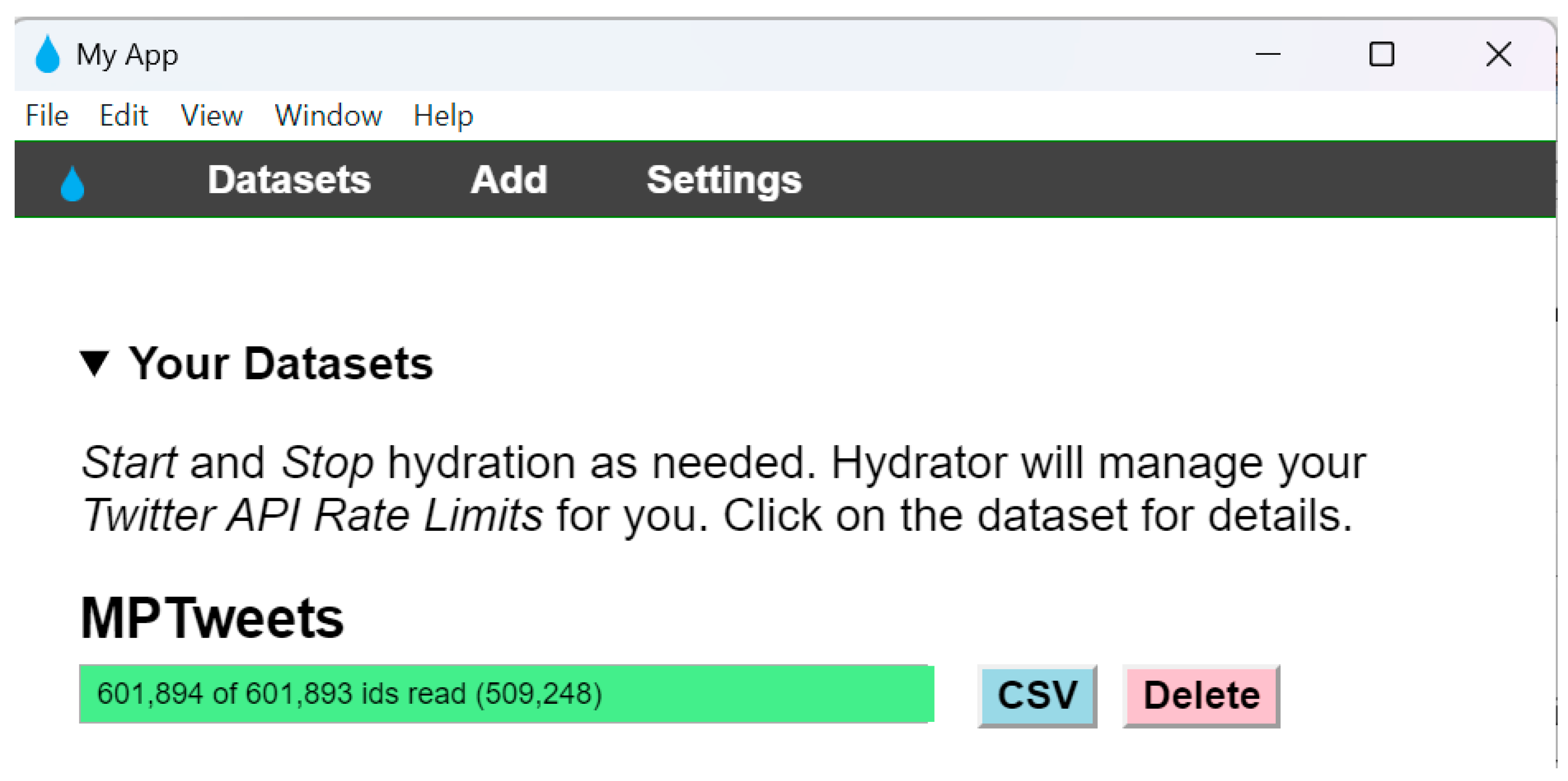
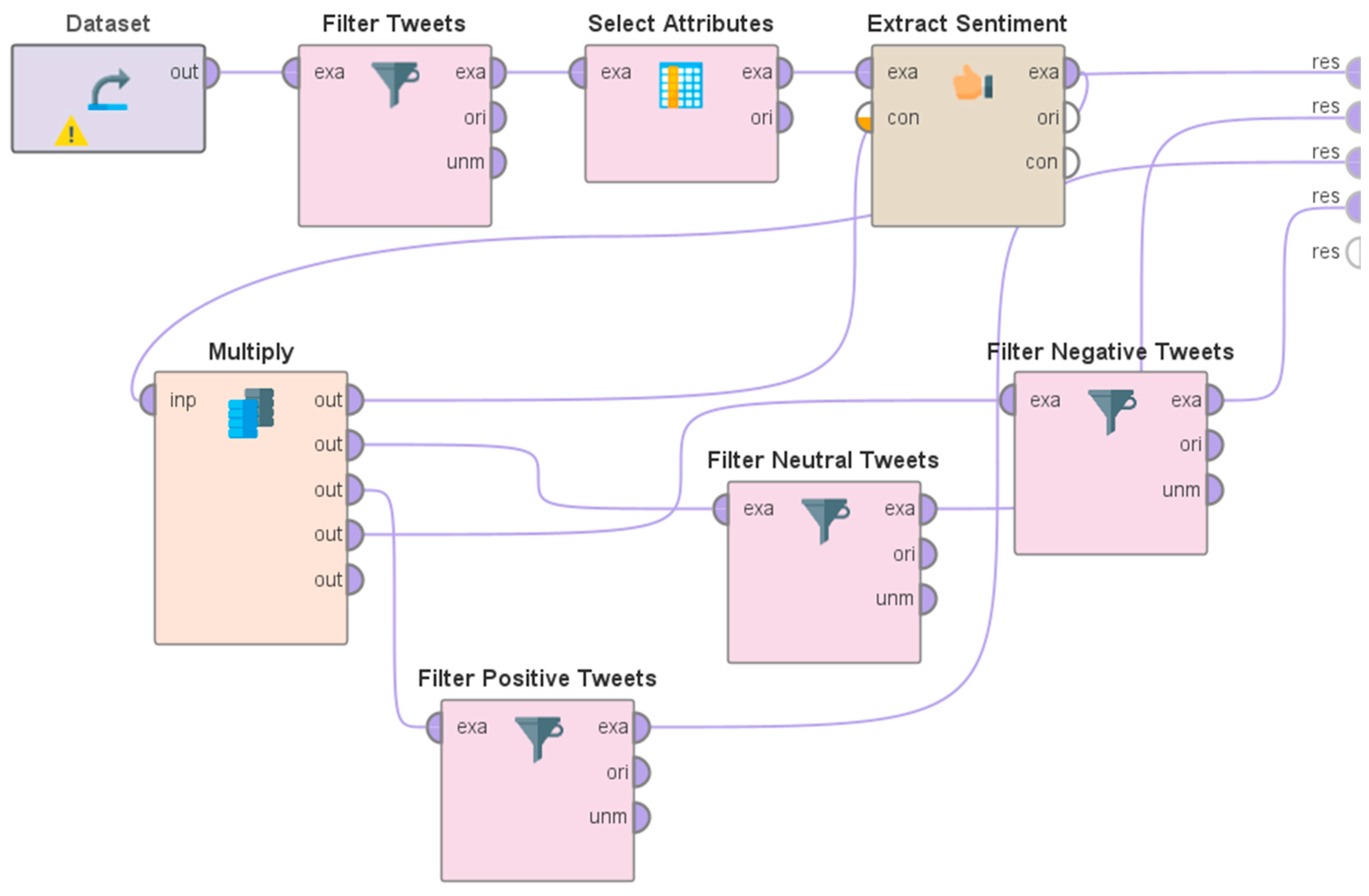
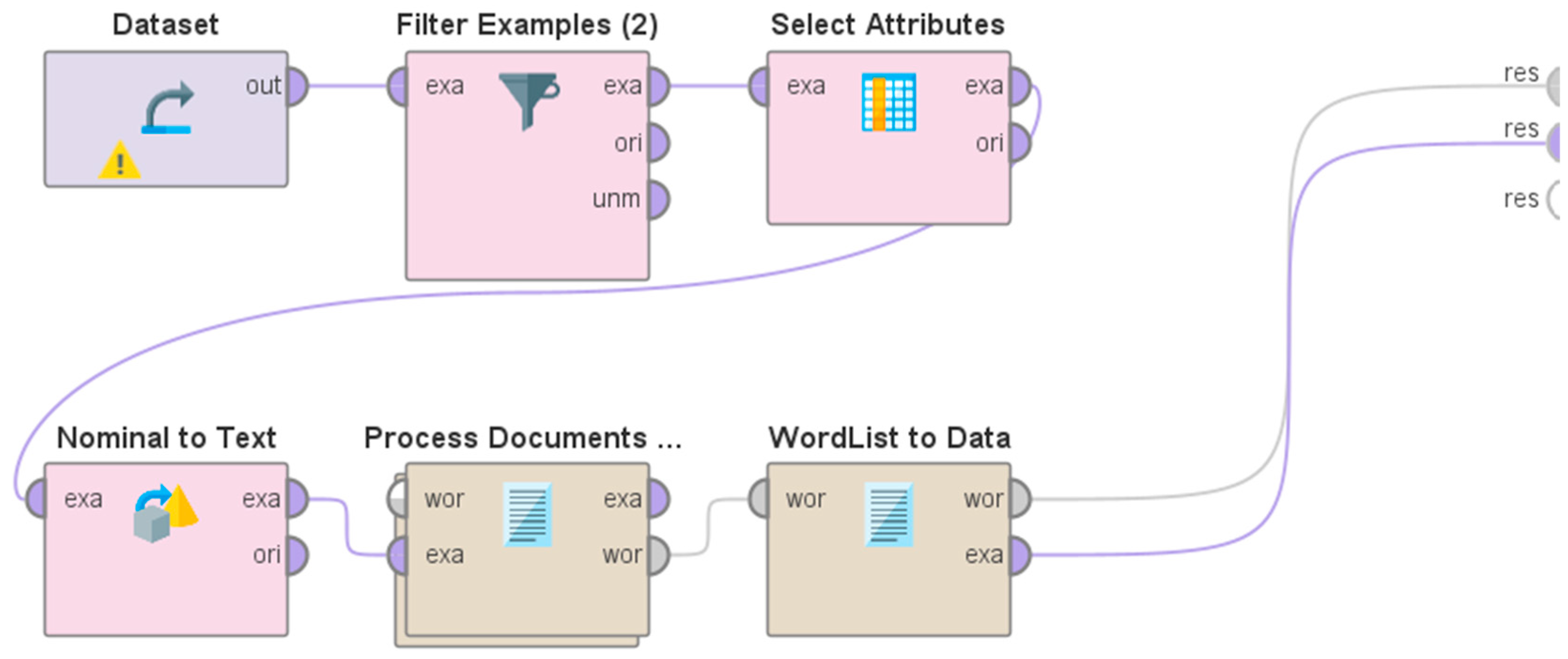
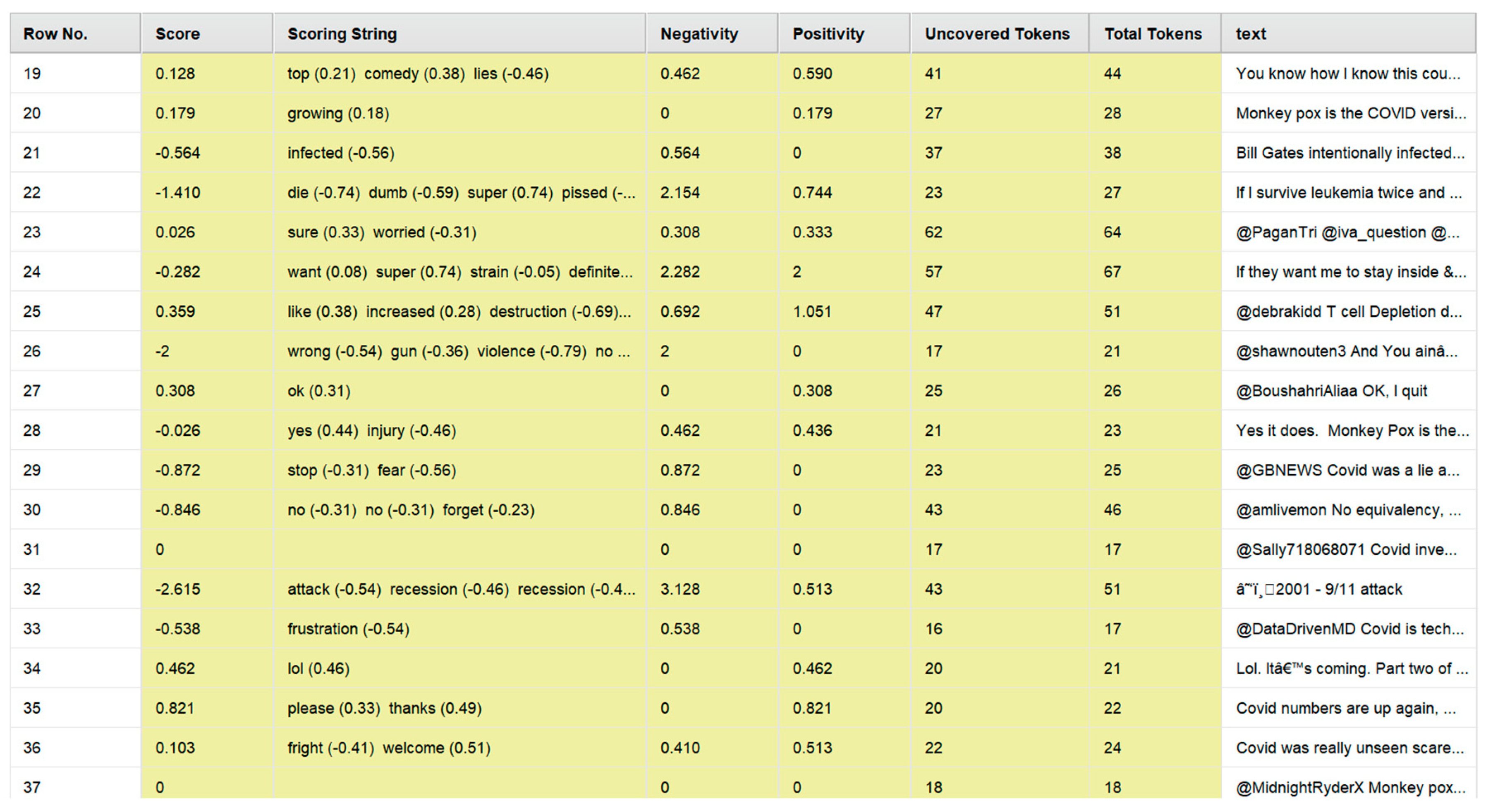
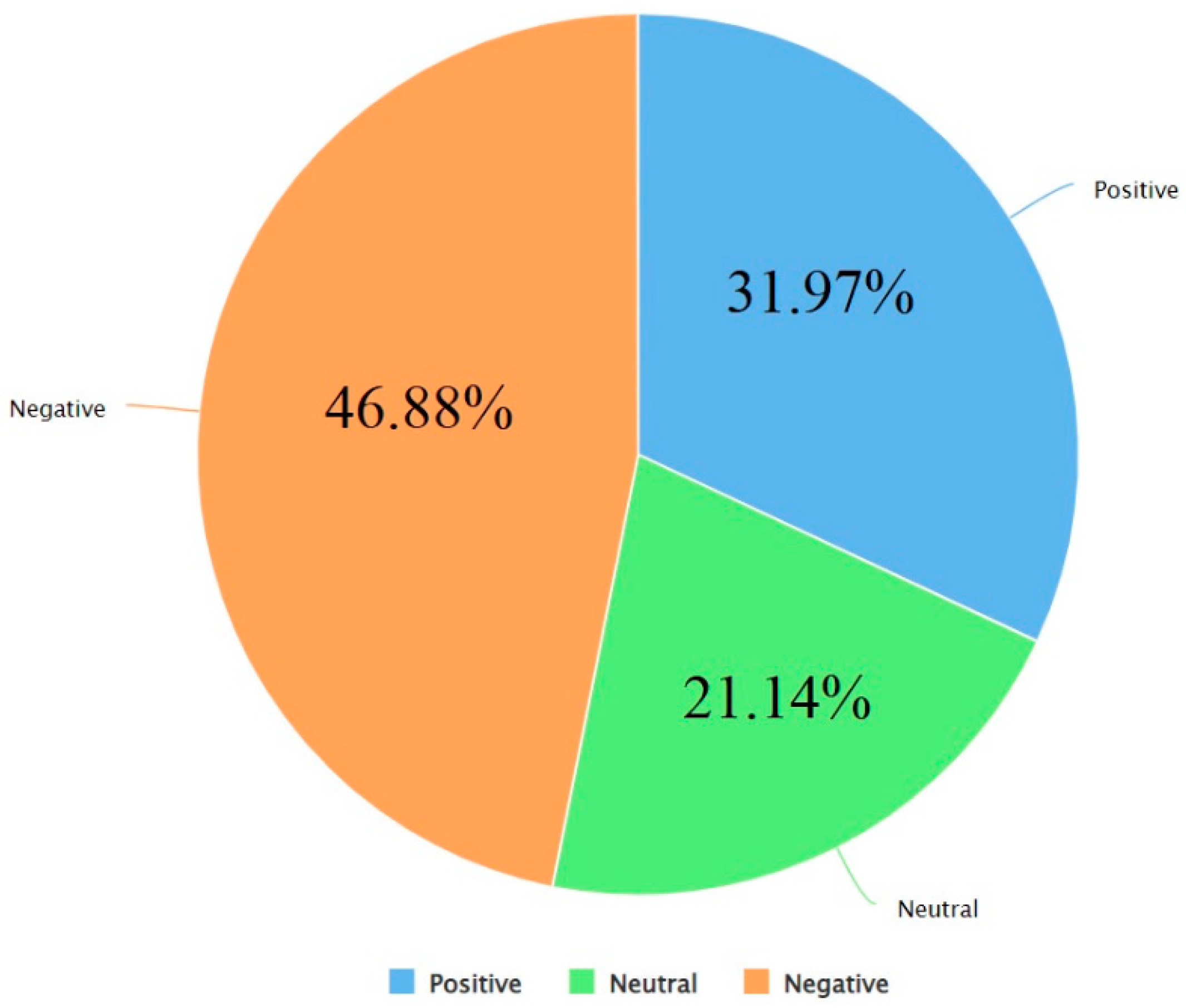
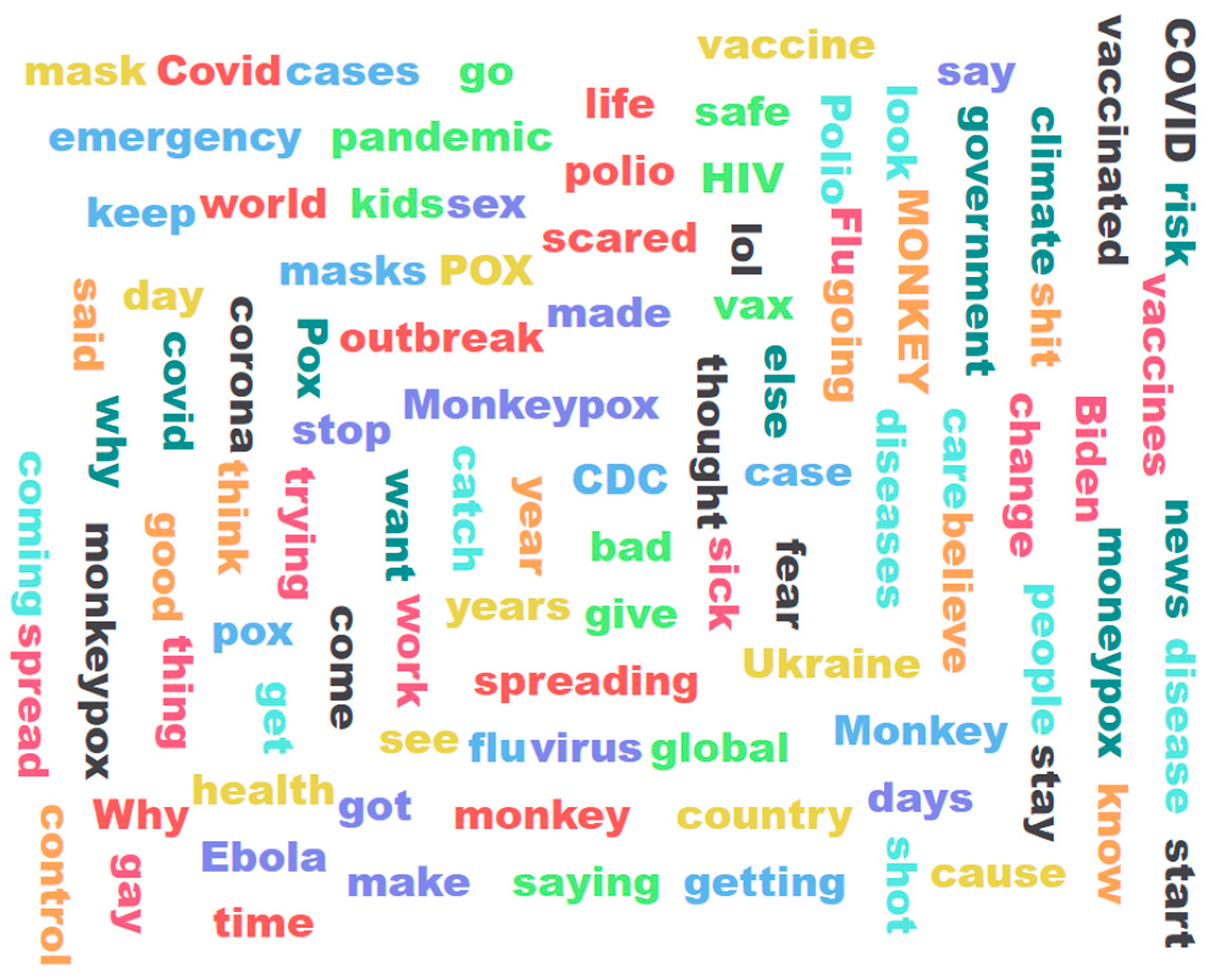
| Tweets related to COVID-19 and MPox | |
|---|---|
| Tweet #1 | They cant figure out how Monkey Pox got here without traveling, and why people are susceptible to it after Covid? Try looking at your immune system after taking the vaccines. Every disease that ever was, is now something for you to fear. Your immune system has been compromised. |
| Tweet #2 | Thanks all you biden fans letting in all these illegal immigrants that have been coming every day since Biden took office. Now we have to worry even more about a new virus coming into this country Monkey Pox forget Covid welcome MONKEY POX |
| Tweet #3 | So, I've got my rainbow sticker, Thank you NHS on my window,' I've had my covid vaccine' on my fb page, Ukraine flag in the garden. It still isn't enough to show how nice I am! Just need a monkey pox sticker. Deffo going to heaven. Stay safe everyone |
| Tweet #4 | MONKEY POX, I am so not ready for you to show up anywhere.Can you imagine the dilemma of future docs, Now with long COVID , long monkey, monkey heart, monkey lungs, monkey brain might emerge. a monkey mask might help. If lived long enough, might have COVID docs, monkey docs etc |
| Tweet #5 | Are you kidding me, now Monkey Pox?! I've spent 3 years caring for my ill wife, fighting against Covid, and trying to survive...now this?! Some days... |
| Tweet #6 | I sure hope the Government doesn't plan to try to force everyone to get monkey pox vaccines. I'd hate to see where that goes so shortly after covid. |
| Tweet #7 | Another lockdown is incoming. They are trying to make monkey pox look like a pandemic. Their media tools are ready, their vaccines were ready before the pox was introduced. These were the same people that played the COVID19 play. They just changed the name of the movie. Failure! |
| Tweet #8 | Monkey Pox new Covid. Election is coming. Coincidence? No |
| Tweet #9 | First it was maga. Then there came covid. Now, it's Monkey Pox. When will these horrors end?!? |
| Tweet #10 | No longer scared of disease be it Covid or Monkey pox; I'm scared of loosing more years of my life ... |
| Hashtag. | Frequency |
|---|---|
| monkeypox | 350 |
| COVID19 | 97 |
| Monkeypox | 88 |
| monkeypox COVID19 | 77 |
| COVID19 monkeypox | 64 |
| COVID | 31 |
| MonkeyPox | 29 |
| SchlongCovid | 27 |
| monkeypox COVID | 24 |
| CovidIsNotOver | 21 |
| covid monkeypox | 21 |
| COVID monkeypox | 19 |
| MonkeypoxVirus | 18 |
| monkeypox Covid_19 | 17 |
| covid19 | 16 |
| COVIDisAirborne | 15 |
| moneypox | 15 |
| monkeypox covid | 15 |
| schlongcovid | 15 |
| auspol | 14 |
| COVID19 Monkeypox | 13 |
| CovidIsNotOver monkeypox | 12 |
| Monkeypox COVID19 | 12 |
| Covid monkeypox | 11 |
| Covid19 | 11 |
| LongCovid | 11 |
| covid | 11 |
| covid19 monkeypox | 11 |
| Covid_19 | 9 |
| Covid_19 monkeypox | 9 |
| LoveIslandUSA | 9 |
| MoneyPox | 9 |
| monkeypox covid19 | 9 |
| Monkeypox COVID | 8 |
| PrimeMorning | 8 |
| monkeypox monkeypox | 8 |
| COVID19aus COVID19vic Wearamask | 7 |
| Covid | 7 |
| Covid19 monkeypox | 7 |
| LoveIsland | 7 |
| MedTwitter | 7 |
| MonkeyPox COVID19 | 7 |
| monkeypox CovidIsNotOver | 7 |
| rogerbezanis LetsGoBrandon | 7 |
| Covid Monkeypox | 6 |
| FJB | 6 |
| Russia Ukraine StopTheTreaty monkeypox BuildBackBetter NWO COVID19 GreatReset arrestBillGates FireFauci | 6 |
| SmartNews | 6 |
| cdnpoli | 6 |
| covid Monkeypox | 6 |
| Word. | Frequency |
|---|---|
| pox | 40154 |
| monkey | 34485 |
| Covid | 25992 |
| covid | 21385 |
| Monkey | 15963 |
| COVID | 15078 |
| Pox | 10051 |
| monkeypox | 6578 |
| people | 6223 |
| get | 5968 |
| going | 3763 |
| vaccine | 4040 |
| Monkeypox | 3247 |
| got | 3004 |
| time | 2744 |
| know | 2579 |
| shit | 2565 |
| virus | 2540 |
| go | 2331 |
| think | 2286 |
| pandemic | 2226 |
| flu | 2096 |
| want | 2008 |
| polio | 1939 |
| getting | 1985 |
| health | 2005 |
| cases | 2036 |
| spread | 2006 |
| see | 1895 |
| world | 1823 |
| vaccines | 1808 |
| thing | 1614 |
| why | 1586 |
| mask | 1559 |
| years | 1518 |
| make | 1393 |
| disease | 1365 |
| said | 1373 |
| work | 1403 |
| say | 1237 |
| keep | 1167 |
| Polio | 1128 |
| POX | 1133 |
| scared | 1216 |
| fear | 1155 |
| outbreak | 1125 |
| Biden | 1131 |
| Ukraine | 1064 |
| year | 1127 |
| emergency | 1146 |
| stop | 1119 |
| come | 1033 |
| gay | 1092 |
| change | 1017 |
| spreading | 1010 |
| good | 1006 |
| coming | 985 |
| masks | 987 |
| global | 973 |
| bad | 954 |
| HIV | 943 |
| climate | 925 |
| trying | 897 |
| Why | 940 |
| day | 898 |
| MONKEY | 862 |
| news | 903 |
| vaccinated | 893 |
| cause | 862 |
| stay | 827 |
| vax | 1001 |
| government | 820 |
| care | 844 |
| safe | 810 |
| else | 769 |
| CDC | 822 |
| made | 785 |
| days | 802 |
| country | 765 |
| shot | 979 |
| Flu | 755 |
| sick | 765 |
| believe | 750 |
| case | 758 |
| risk | 791 |
| start | 717 |
| corona | 727 |
| catch | 736 |
| control | 753 |
| thought | 711 |
| saying | 725 |
| look | 706 |
| diseases | 720 |
| Ebola | 714 |
| moneypox | 689 |
| kids | 744 |
| life | 699 |
| sex | 756 |
| give | 695 |
| Lol | 691 |
| Work | SA of Tweets about COVID-19 | SA of Tweets about MPox |
|---|---|---|
| Vijay et al. [44] | ✓ | |
| Mansoor et al. [45] | ✓ | |
| Pokharel [46] | ✓ | |
| Chakraborty et al. [47] | ✓ | |
| Shofiya et al. [48] | ✓ | |
| Basiri et al. [49] | ✓ | |
| Cheeti et al. [50] | ✓ | |
| Ridhwan et al. [51] | ✓ | |
| Tripathi [52] | ✓ | |
| Situala et al. [53] | ✓ | |
| Gupta et al. [54] | ✓ | |
| Alanezi et al. [55] | ✓ | |
| Dubey [56] | ✓ | |
| Rahman et al. [57] | ✓ | |
| Ainlet et al. [58] | ✓ | |
| Slobodin et al. [59] | ✓ | |
| Zou et al. [60] | ✓ | |
| Alhuzali et al. [61] | ✓ | |
| Hussain et al. [62] | ✓ | |
| Liu et al. [63] | ✓ | |
| Hu et al. [64] | ✓ | |
| Khan et al. [65] | ✓ | |
| Ahmed et al. [66] | ✓ | |
| Lin et al. [67] | ✓ | |
| Jang et al. [68] | ✓ | |
| Tsao et al. [69] | ✓ | |
| Griffith et al. [70] | ✓ | |
| Chum et al. [71] | ✓ | |
| Kothari et al. [72] | ✓ | |
| Barkur et al. [73] | ✓ | |
| Afroz et al. [74] | ✓ | |
| Hota et al. [75] | ✓ | |
| Venigalla et al. [76] | ✓ | |
| Paliwal et al. [77] | ✓ | |
| Zhou et al. [78] | ✓ | |
| Lamsal et al. [79] | ✓ | |
| Zhou et al. [80] | ✓ | |
| de Melo et al. [81] | ✓ | |
| Brum et al. [82] | ✓ | |
| de Sousa et al. [83] | ✓ | |
| Iparraguirre-Villanueva et al. [84] | ✓ | |
| Mohbey et al. [85] | ✓ | |
| Farahat et al. [86] | ✓ | |
| Sv et al. [87] | ✓ | |
| Bengesi et al. [88] | ✓ | |
| Dsouza et al. [89] | ✓ | |
| Zuhanda et al. [90] | ✓ | |
| Cooper et al. [91] | ✓ | |
| Ng et al. [92] | ✓ | |
| Thakur [this work] | ✓ | ✓ |
Disclaimer/Publisher’s Note: The statements, opinions and data contained in all publications are solely those of the individual author(s) and contributor(s) and not of MDPI and/or the editor(s). MDPI and/or the editor(s) disclaim responsibility for any injury to people or property resulting from any ideas, methods, instructions or products referred to in the content. |
© 2023 by the authors. Licensee MDPI, Basel, Switzerland. This article is an open access article distributed under the terms and conditions of the Creative Commons Attribution (CC BY) license (http://creativecommons.org/licenses/by/4.0/).




